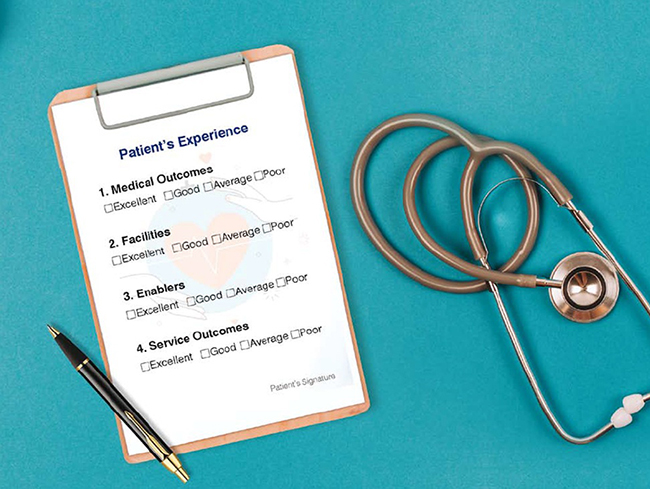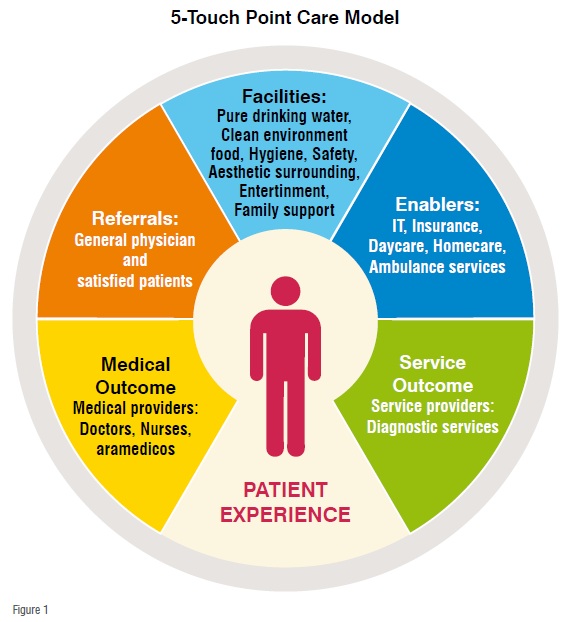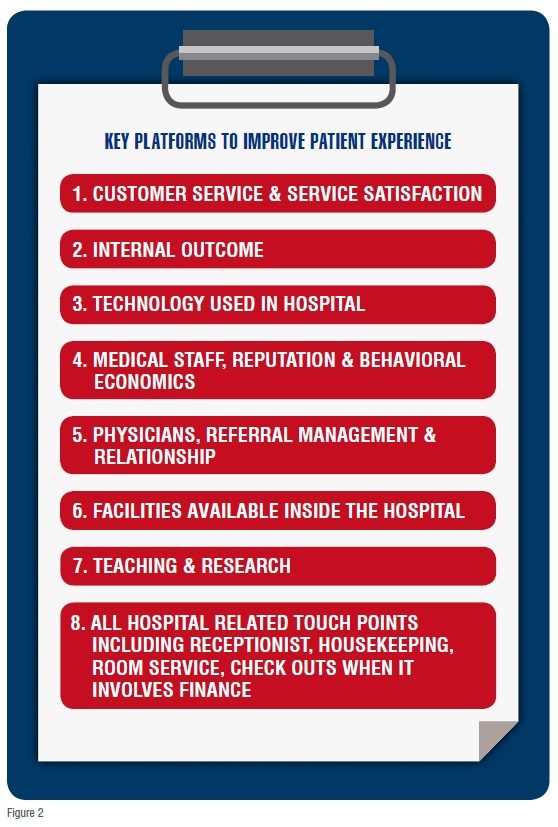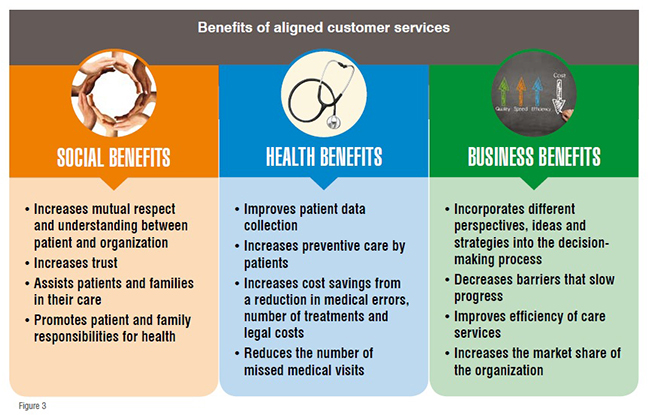Care models help hospitals set up measures to ensure a positive patient perception to increase loyalty & branding and to ensure smooth patient flow and pathways, thereby increasing hospital productivity & turnover. Today as healthcare becomes an out-of-pocket expense, consumers are seeking value in their health purchases. In this context, value is the cost relationship between an expense and quality, which most healthcare consumers equate with service and a positive experience. Hospitals that respond to this are poised to thrive in this era of healthcare consumerism.
It is the duty of care providers to realise that a hospital is more than a business; it is an imperative service to patients and families and supporting them morally at the most challenging and critical times of their lives are our duty. Apart from keeping patients informed and engaged, mollifying the censorious environment, and ensuring that the patient feels supported at their stress times helps accelerating the healing process. This leads to improving their experience and creating positive brand image.

The process of creating good perception of the organisation starts from a very when a patient or family approaches the organisation; thus the role of the receptionist is in influencing and providing embossing guidance. In today’s world, customer is considered the king, making it essential for every organisation to keep its consumers satisfied by providing excellent quality service and value and maintain in the competitive market. Thus, customer satisfaction is the keyword in today’s powerful competitive business world.
A care model can be designed in such a way that it remains seamless, profitable and enhances patient/ consumer experience. At each touch point, patient experience is crucial.
As healthcare pursues the goal of providing access to maximum number of population, its objective is to do so at lower costs. Adoption of new technologies, medications, and approaches have altered the way of delivering care. The old saying, "If you don’t create change – change creates you” applies over here. The care model represents the various ways by which the healthcare services are provided. The referrals provide insights and direct the patients towards medical and healthcare services. The medical providers like doctors, paramedical staff, provide medical services to patients and service providers including diagnostic services, blood banks, and pathology labs provide service outcomes while treating the patient. In addition to the services the surrounding environment and facilities available in the hospital plays a major role. Facilities like pure drinking water, food canteen, clean and hygienic environment, entertainment, aesthetic surrounding, and availability of essential requirements to support family members leads in creating positive image of the system. In addition to these basic services, health Insurance to take care of bills, daycare services, homecare services, ambulance services with life support and medical staff in emergency cases, robust IT services in supporting the services and technologies are playing the role of enablers in healthcare system.

The parameter that attracts the patient apart from the treatment is the services, and facilities that satisfy their needs and provide comfort. The key points that patient will look at in the hospital system includes appropriateness (relevant to patient care), timeliness, efficacy & effectiveness (right treatment at right time), safe & clean environment, and digitalisation to make processes impler.
The basic elements that The Hospital Consumer Assessment of Healthcare Providers and Systems (HCAHPS) are tracking covers the points mentioned below. The personal effort by everyone at the facility incorporates good customer service. Some items listed, such as clean rooms and quiet atmosphere, can be improved by administrative policies and protocols. Fig 2.
In order to really meet and exceed the expectations of customers from diverse communities, it is important to learn and practice the basic principles of customer service, which are:
• Staff has to be respectful, courteous and polite
• Staff should make the customer feel welcome
• Give your undivided attention and time when interacting with customers
• Be friendly and learn about the cultures in the communities you serve
• Develop excellent communication skills with patients and families to bridge language and cultural barriers
• Appreciate the value of the customer’s time
• Develop excellent communication skills with co-workers
• Be dependable/ credible
• Make the extra effort to build relationship with customer.
These basic principles will let patients know you care, that they are not just another number, and that their business is invaluable.
1.Waiting Period
Reduction in waiting times operationally and implementing self-service kiosks to speed up the registration process and is found to be associated with higher patient satisfaction.
Some distractions like televisions, Wi-Fi, or a garden for children’s play areas helps to reduce patient anxiety. Depending on the majority of customer age group the nature and content of the distraction can be chosen. For example, educational posters displayed in waiting rooms will impart knowledge and educate the people thereby providing distraction from waiting time period.
2. Digitisation
Digitisation is enabling centralised database that would contain all aspects of patients’ health, reducing the errors, and making processes easier. By going digital, delivery of healthcare services can be made flexible and efficient beyond the brick and mortar constraints of traditional medicine. The power of digitisation in healthcare is observed in eHealth, which is a part of the government programme Digital India. Other online processes like ePharmacy, eDiagnostics, eInsurance, eReferrals, would provide a robust ecosystem support to the patients and service providers. The inconvenience resulting due to registration and other formalities can be tackled by customers identifying themselves through the Aadhar number.

3. Behavioural Economics
The principles of Behavioural Economics (BE) can be related to the social aspects of healthcare. Patient-related decisions which often involve a certain amount of risk, an understanding of which can be benefited from BE. The doctors can help patients to make informed decisions by offering clear comparison. Example-Giving feedback to patients on how they are reacting to treatment and what is the progress, will motivate people towards treatment, & effectively trigger a desire to change behaviour and improve to do better than average. This has been used, to convince patients to quit smoking, by giving them feedback on the ‘age’ of their lungs.
4. Impact of Technology
Technology will help in reduction of healthcare costs by allowing clinical staff to remotely work together and instantly access patient data. This will serve a growing population of patients by allowing physicians to remotely monitor the chronic illnesses, patient’s long—term health, and out of hospital care. Improvisation in diagnoses by bringing together data from disparate devices (e.g. monitors, images, therapeutic devices) over time will help to form a complete picture of a patient’s health status. Technology helps improve medical equipment functionality and maintenance. For example, wireless sharing of information improves the functioning of healthcare ICT systems. Technology also allows monitoring of the consumption of medicines on time, reduction in the time taken to settle insurance claims and admissions for insured persons, and provide the data generated in an ambulance during the transit to the hospitals and doctors in real-time, thereby making the emergency care more efficient. In most of the cases, however, the ambulance and the ICT system of hospitals have difficulty in integrating and exchanging information.
Designing the processes to streamline the healthcare services technology is bringing a revolutionary change across healthcare sector. By enabling telemedicine to reach to rural communities, technology is creating a way forward for healthcare to address major challenges.

The benefits that an organisation will gain from systematic and aligned customer services are mentioned below.Fig3.
Lean management applied in healthcare aims at boosting productivity, improving customer and employee satisfaction thereby reducing the lead time. Analysing the current situation of the hospital and to assess the suitability of lean activities is essential. As per the needs and requirements of the hospital, optimisation of the goals, methods and accompanying change management can be carried out. This ensures the success and sustainability of lean hospital projects. Lean hospital management offers leaders many possible ways to establish professional, process-driven healthcare organisations.